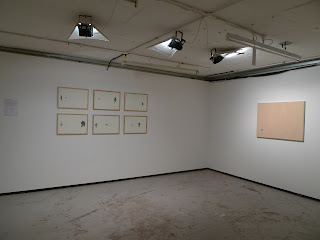 |
| Plus 1, Installation view |
The selection of artists for a group show can be based on various things; a theme, a medium, a style or a location, for example. In the case of Plus 1 currently showing at the Arts at The Old Fire Station Gallery in Oxford, the selection of artists is defined by relationships.
Launch Collaborative, the collective that curated the show, are an initiative that aims to connect and promote emerging artists’ work by providing a platform to exhibit and work collaboratively. The organizing principle of Plus 1 exemplifies this ambition by celebrating existing relationships and creating the possibility of new ones; an appropriate theme for the first show of the year in a new and exciting arts centre. The six exhibiting artists are made up of three pairs. Each pair includes one artist selected by Launch Collaborative and their nominated 'plus one’. An element of control having been removed from the organisers, one might worry that the strong connections between the pairs of artists could lead to a discordant whole. However, this is not the case. The nature of the risk is in harmony with the ethos of the show to create new links between practices and provide a space for a reflexive reading of the work.
Exhibited together in an intimately sized space, the mind naturally begins to construct a web of relationships between the works. The expansive mechanism of the plus one invitation is emulated by an exploration of the works in relationship to each other, drawing a spider diagram of thoughts and ideas: ‘we perceive that the familiar world assumes the new relief of a dazzling cosmic miniature, we did not know that the familiar world was so large.’
This poetic description of the concept of the miniature by Gaston Bachelard aptly describes the conceptual and visual flip between the microscopic and the vast observable in several works. In the case of both Jaya Mansberger’s paintings and Matt Blackler’s process pieces it is often hard to tell how wide or narrow one’s focus is. The detailed abstraction of Mansberger’s works could signify a nebula of stars or conversely, material under a microscope. Side by side Heavenly bodies and Just Blushing pivot between expansion and contraction. The elements of Jetsam could be infinitely large or tiny, or indeed both, as Blackler’s A Day at the Frontier implies.
Blackler’s practice turns processes inside out to the point of absurdity. Whilst 200 fruit boxes Part 1 and 2 run a manufacturing procedure backwards to create intricately layered wooden logs from fruit crates, Stargazer looks out through a series of lenses, stretching its reach to a gap in the stars. At the same time, the addition of each lens limits the amount of light able to pass through to a smaller and smaller degree. This wry inversion inspires an unexpected sense of wonder in the three photo etchings displayed alongside Stargazer; dust, nothingness and the stars. Vastness contained in a tiny dark square.
 |
| Jaya Mansberger, Heavenly Bodies. Oil on Canvas |
This romanticism coupled with humour extends through the exhibition from Chloe Le Tissiers ambiguous landscapes and out of place wild animals, to Toni Le Busque’s self deprecating and outrageously honest prints. A compilation of words, statements, symbols and characters, Le Busque’s pieces are disarming; brutally direct but with a likable self knowledge. A hopeful celebration of the everyday, constructing meaning out of human details, experiences and obsessions, is also to be found in the work of Wayne Adams. In Lewis Hamilton, a rotating speaker plays a recording of the artist emulating the noise of race car driver Lewis Hamilton making his fastest lap at Silverstone in 2011. The sound is instantly recognisable (we’ve all made that sound before) and the piece has a similar wryness to Blackler’s work, pushing absurdity to the edge of beauty: as the continuous loop is broken down it signifies individual events of importance within it.
Despite an approachable lightness in the aura of the works exhibited in Plus 1, they all ask for a keen attention to detail, whether it be the intricacies of Blackler’s concepts, the flowing combination of abstraction and representation hiding ethereal forms in Le Tissier’s paintings, or the subtleness of the racing car sleekness in the nude wooden casing of Adam’s construction. Processes are filtered, elements broken down and recombined, each part a significant piece of the whole, much like Amy Waters’ overlapping block letters; each a constituent part, separate and yet fading into one another. Plus 1 brings together an eclectic combination of artists for an expansive dialogue in a small space, whilst retaining a enjoyable coherence. However, if 'attention to detail is an enlarging glass’, then there is an almost infinite amount to take in.
Quotes from ‘The Poetics of Space’ by Gaston Bachelard and his writing on the Miniature.















